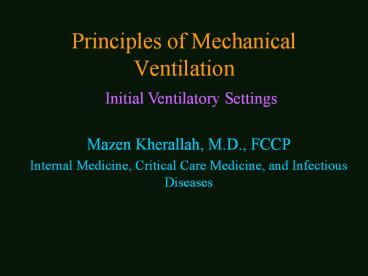Principles of Mechanical Ventilation - PowerPoint PPT Presentation
1 / 28
Title:
Principles of Mechanical Ventilation
Description:
... Drug intoxication CNS disorders Peripheral neurological disorders Pharmacological Paralysis Limitations: Patient-ventilator ... compliance NL /( Static ... – PowerPoint PPT presentation
Number of Views:583
Avg rating:3.0/5.0
Title: Principles of Mechanical Ventilation
1
Principles of Mechanical Ventilation
Initial Ventilatory Settings
- Mazen Kherallah, M.D., FCCP
- Internal Medicine, Critical Care Medicine, and
Infectious Diseases
2
Modes of Mechanical Ventilation
Volume-Cycled Control Mode Ventilation
3
Volume-Cycled Control Mode Ventilation
- Indicated for patients who are unable to
ventilate - Drug intoxication
- CNS disorders
- Peripheral neurological disorders
- Pharmacological Paralysis
- Limitations
- Patient-ventilator dysynchrony secondary to
aborted ventilatory cycles when patient exhales
during ventilator inspiratory cycle - Hypercapnea
4
Modes of Mechanical Ventilation
Assist-Control Ventilation
5
Assist-Control Ventilation
- Indications
- for patients who are awake, moderately sedated
or paralyzed and able to initiates ventilation - increase metabolic demands infection, burns,
multisystem organ failure - Respiratory muscle strengthening and weaning
- Limitations
- patient-ventilator dysynchrony
- ventilator assisted hyperventilation in agitated
patients with increased inspiratory drive - auto-PEEP in COPD patients
6
Modes of Mechanical Ventilation
Intermittent Mandatory Ventilation
7
Modes of Mechanical Ventilation
Synchronized Intermittent Mandatory Ventilation
8
Synchronized Intermittent Mandatory Ventilation
- Indications
- patients with minimal spontaneous respiratory
efforts - respiratory muscle conditioning
- ventilator weaning
- Limitations
- patient-ventilator dysynchrony especially in
agitated patients - nonphysiologic way of respiratory muscle
conditioning
9
Modes of Mechanical Ventilation
Pressure Support Ventilation
10
Pressure Support Ventilation
- Indications
- weaning
- more physiologic conditioning of respiratory
muscles low pressure-high volume load - improved patient-ventilator dysynchrony
- Limitations
11
Modes of Mechanical Ventilation
Inverse Ratio Ventilation
12
Distribution of Normal Ventilation-Perfusion
Ratios
1
10
0.1
0
13
Oxygen-carbon dioxide diagram
14
The Effect of Increasing Ventilation-Perfusion
Inequality on Arterial Po2 and Pco2
15
Ventilation-Perfusion Inequality
Acute Exacerbation of COPD
0 .01 0.1
1 10 100
16
Ventilation-Perfusion Inequality
Asthma
0 .01 0.1 1
10 100
17
Ventilation-Perfusion Inequality
Pulmonary Embolism
0 .01 0.1 1
10 100
18
Shunting Process
ARDS
0 .01 1
10 100
19
The effect of changing the inspired oxygen
concentration on arterial Po2 for lungs shunts
of 10 to 50
20
(No Transcript)
21
Pulmonary Mechanics
Peak pressure
Airway Resistance
Plateau pressure
I
E
22
Static Pressure-volume curve in ARDS with PEEP of
0 and 12
12 PEEP
0 PEEP
23
Auto-PEEP
24
Auto-PEEP
25
Normal Lung Mechanics and Gas Exchange
26
Severe Airflow Obstruction
27
Acute on Chronic Respiratory Failure
28
Acute Hypoxemic Respiratory Failure





![[PDF] Essentials of Mechanical Ventilation 3rd Edition Full PowerPoint PPT Presentation](https://s3.amazonaws.com/images.powershow.com/10075605.th0.jpg?_=20240709108)

























